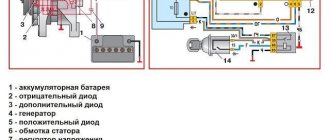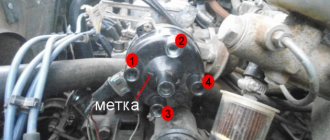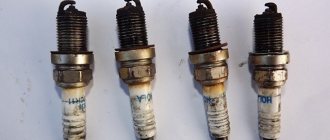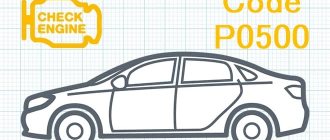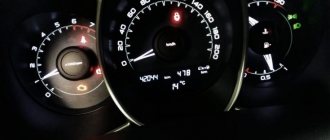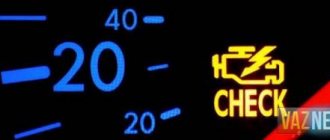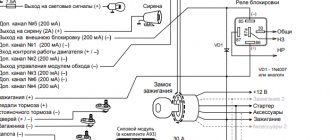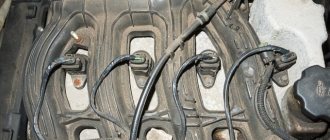Types of tire tread patterns
Modern tires are divided into three types depending on the design of the tread. The difference in the pattern allows manufacturers to adjust the characteristics of the product to certain road conditions.
Also, the shape of the pattern affects the noise and wear resistance of the slope.
Rubber without pattern direction
Typically, such rubber is intended for agricultural machinery and off-road vehicles. A non-directional pattern is the simplest and most cost-effective type, capable of working equally regardless of the rolling side.
The disadvantages include loud noise during acceleration and mediocre stability at high speeds.
Rubber with directional symmetrical pattern
A popular type of tread, used primarily for winter tires.
Thanks to the abundance of moisture drainage, the slopes hold up well on wet roads and are resistant to aquaplaning. The “V”-shaped pattern makes minimal noise and holds the road well. A nuance is the requirement for correct installation (strictly in the direction of the arrow). If you break the rule, loss of characteristics and accelerated wear are possible.
Tires with asymmetric pattern in direction
The asymmetrical directional tread is the most difficult to produce.
Thanks to this design, the tire combines cornering stability and optimal grip on straight sections. The improved performance of hybrid technology guarantees an advantage on the race track. For the average user, the advantages are not noticeable - at low speeds in city mode, the slopes cannot reveal their full potential.
Classification
Tires are classified according to the following criteria:
- by type of tread pattern - directional, non-directional (universal), asymmetrical;
- according to the specifics of adhesion to the road surface - summer, winter, universal;
- according to the characteristics of the tread relief - symmetrical, asymmetrical;
- according to the degree of rigidity - hard - for driving on dry roads, soft - on wet roads;
- according to the depth of the wheel tread relief - with lugs for driving on swampy soil, average depth of the channels of common road surfaces, smooth for sports cars;
- by functional purpose - passenger cars, trucks;
- in the direction of fastening the threads in the cord (allows you to determine the load capacity of the car and the required pressure for inflation) - diagonal (threads cross, greater rigidity, less pressure is required when pumping), radial - threads parallel to each other - fewer layers of cord, less weight, longer service life , more carrying capacity;
- according to the sealing method - chamber - with a sealed chamber, rim - pumping air into the cavity between the wheel rim and the frame, through a valve.
You should understand! Universal ones are inferior to specialized ones in terms of reliability while driving. Directional ones provide better grip on wet roads at high speeds. If you correctly determine the direction behind the rotation of the wheels, the effect of aquaplaning disappears, which guarantees good grip of the rubber on puddles.
Which side should you put the tire on the car rim?
Experienced motorists know that each tire has a direction of rotation.
If you put the wheel on the car incorrectly, its efficiency is greatly reduced. Tread wear also increases, which leads to rapid wear of the studs and increased movement noise. Special inscriptions such as Rotation, Outside will help you find out which side to put the tires on the car. Designations are applied to the sidewalls, and the indices are relevant for all manufacturers. Regardless of the brand, be it Hankuk or Rossava, the labeling is the same.
Rotation
Tire rotation direction
Some tires (for example, Bridgestone) can be swapped. This is done only crosswise. This means that it is possible to drive 45-60 thousand kilometers, and after that change the location of the wheels. It is possible to put a front left one in place of the right rear one, and a front right one in place of the left rear one. This can be done with the front wheels, but in a strictly defined order.
If the direction of tire movement is specified, the wheels are rearranged on one side, i.e. Front tires are swapped for rear tires and vice versa.
When the tires are symmetrical, it is possible to change the arrangement in any order.
How to properly install directional tires
Tires with a symmetrical, directional tread pattern are the easiest to install. Arrows may not be drawn here - the desired stripe is indicated by the drawing itself. Typically, on such rubber, the arrangement of studs is a herringbone pattern. The front part of the arrow, when viewing the tire from above, should face the direction of travel of the car.
The photo shows the correct installation of a symmetrical directional tire.
Asymmetric tires can be installed similarly. If there is a characteristic stretch on the working surface, this is how the installation is performed.
On models where the clear direction of the pattern is not visible, you need to navigate using the side indicators. The pictures show the most common tire designations. Asymmetrical tread – meaning of the inscription: located on the inside of the wheel:
Designation of the direction of rotation - the arrow points forward:
Is it possible to install tires with different treads?
Sometimes car owners are more concerned about savings than safety and buy only 1 tire instead of replacing the entire set. As a result, the car sits on tires with different patterns. But already in the traffic rules it is noted that it is strictly forbidden to put wheels with different patterns on the same axle (front or rear). According to car enthusiasts, sometimes this is acceptable.
But this is definitely a bad idea because:
- The sipes and grooves are different, and the braking characteristics (speed and braking distance) are also significantly different. In an emergency stop, this can cause a skid and lead to an accident.
- Road grip and hydroplaning will also vary, which is very dangerous when driving fast.
- The treads wear unevenly, as rubber compounds of different quality are used.
- All tests and, accordingly, indicators declared by world-famous manufacturers are based on compliance with the condition of a complete set of tires.
How to properly put tires on a car if there is no direction sign
For tires where there are no arrows or similar indicators, it makes no difference how they are installed on the car. Due to the fact that there is nothing to show the required side, tires with non-directional tread work equally in both directions. Such slopes are distinguished by a specific design of spikes. The elements have symmetrical bevels on both sides.
Asymmetric tires
- Yandex.Market rating: Yandex.Market: 4.5
Goodyear Eagle F1 Asymmetric 3 SUV tiresSeasonality: summer Spikes: no Diameter: 17 / 18 / 19 / 20 / 21 / 22
- Yandex.Market rating: Yandex.Market: 4.5
Goodyear Eagle F1 Asymmetric tires
Seasonality: summer Spikes: no Diameter: 17 / 18 / 19
- Yandex.Market rating: Yandex.Market: 4.5
Goodyear Eagle F1 Asymmetric 2 tires
Seasonality: summer Spikes: no Diameter: 16 / 17 / 18 / 19 / 20
- Yandex.Market rating: Yandex.Market: 4.5
Goodyear Eagle F1 Asymmetric 2 SUV tires
Seasonality: summer Spikes: no Diameter: 19 / 20 / 21
- Yandex.Market rating: Yandex.Market: 4.5
Goodyear Eagle F1 Asymmetric 3 tires
Seasonality: summer Spikes: no Diameter: 17 / 18 / 19 / 20 / 21 / 22
- Yandex.Market rating: Yandex.Market: 4.5
Tires Goodyear Eagle F1 Asymmetric 5
Seasonality: summer Spikes: no Diameter: 17 / 18 / 19 / 20 / 21 / 22
- Tires Goodyear Eagle F1 Asymmetric Suv 4×4
Seasonality: summer Spikes: no Diameter: 19 / 20 / 21
- Goodyear Eagle F1 Asymmetric SUV AT tires
Seasonality: all-season Spikes: no Diameter: 18 / 19 / 20 / 21 / 22
- Yandex.Market rating: Yandex.Market: 4
Goodyear Eagle F1 Asymmetric SUV tires
Seasonality: summer Spikes: no Diameter: 17 / 18 / 19 / 20 / 22
How to determine the direction of winter tires when installing
There are also installation rules for winter tires. Arrows and markings are also used here to indicate correct installation. The inscriptions Rotation, combined with an arrow, and the Outside and Inside markings, indicating the location of the sides, are relevant.
Incorrect installation on winter tires has a greater impact. The soft composition of the stingray is wiped off faster, and the metal spikes fall out easily. Thus, the error reduces the service life of the product by 40-50%.
Tire seasonality
Typically, the tire is marked with information about the season and/or weather conditions for which the tire is intended. Here is what some inscriptions (icons) mean, indicating the seasonal specialization of the tire:
M+S
(
M&S
) –
lugs
.
This inscription in no way means that the tire is winter
, although it stands for Mud and Snow.
In fact, such an abbreviation only means that the tire tread is intended for driving off asphalt, or on asphalt with mud and snow porridge. Such an inscription on the tire says absolutely nothing about the chemical composition of the tire (and this is precisely the main difference between winter tires and summer tires). The M&S marking is applied to winter, all-season and off-road summer tires
.
AS
(All Season),
Any Season
,
All Season
,
R+W
(Road + Winter),
AW
(Any Weather),
AGT
(All Grip Traction) -
options for designating all-season tires
. We remind you that all-season tires are absolutely not intended for use in severe frosts and/or warm weather - only at near-zero temperatures.
Rain
,
Aqua
,
Water
,
Aquatred
,
Aquacontact
, or
a painted umbrella
mean that the tire provides improved water drainage from the contact patch with the road and, accordingly, reduced aquaplaning characteristics - the so-called
rain tires
.
Snowflake painted on the side of a tire
, or the inscription
Winter
indicate
winter tires
.
How to put winter tires in the correct direction
Models with directional tread are also popular for winter. Here, the direction of rotation of the wheels is similarly indicated by an arrow. In its absence, correctness is determined by the location of the tree of thorns. When viewed from above, the tip should be in the direction of travel of the car.
If you install tires incorrectly, their grip on slippery surfaces will decrease and wear on the tread and metal inserts will increase.
How to install winter tires: Guardian tread direction
The symmetrical non-directional tire from Firestone is designed for family cars. The characteristics of the rubber compound are suitable for moderate use in winter. The ramp can be placed on either side.
In which direction should you install Matador winter tires?
Tires of this brand are directional and non-directional. Products are installed according to general rules. To determine the correct location, the MP-52 model contains Rotation arrows.
For asymmetrical tires such as MPS 530, you must adhere to the “Outside and Inside” mounting side indicators.
Michelin studded tread direction
Michelin winter studs are mainly produced with a directional tread design. Such models must be mounted on rims based on arrow indicators or the location of the tread tree.
On similar models such as Michelin Energy, the clear direction of the blocks is not visible. Here you should be guided by the markings on the inner and outer sides of the rubber.
Dunlop tires
Dunlop also produces a wide range of automobile wheels.
Due to trade in Europe and the USA, the brand's products are subject to general labeling regulations. Depending on the model, the tread pattern can be symmetrical or asymmetrical. The direction is determined by arrows or corresponding inscriptions on the sidewalls of the tire.
Bridgestone Blizak
The version designed for crossovers differs from competitors' offerings in its increased cross-country ability and low price. Due to the complex design of the working part, motorists often make mistakes when installing a tire.
To facilitate the procedure, the manufacturer places a Rotation indicator with a characteristic arrow on the side of the ramp, which minimizes the likelihood of incorrect installation.
Kama Irbis
The budget tire Kama Irbis 505 has a pronounced tread direction. If you are careful when fitting tires, it is difficult to confuse the direction. The model has a standard pointer and directional pattern.
Cordiant
The manufacturer Cordiant produces several types of tires. Asymmetrical and symmetrical modifications are popular among motorists. Depending on the design, tires are marked with directional or inner/outer side indicators.
Nokian Nordman 5
In Nordman's fifth version, it is impossible to confuse the correct direction.
There is a pronounced directional pattern and arrow indicators on the sides. The central part of the working platform is a monolithic tree; the tip of the triangle should be directed in the direction of travel of the vehicle.
How to change a tire on a car yourself?
How to change a tire? For the majority of the male population, this question is so simple that it is not even discussed. But what if you damage a tire while traveling and there is no man nearby? You can call technical assistance, or still try to solve the problem without the help of others. Let's find out in practice whether it is difficult to change a tire with gentle women's hands?
It turned out to be completely easy. You don't need to put in a lot of effort to lift the machine. There is also no need to carry wheels. The most difficult thing on some cars is to find a jack and a set of tools. Dear car ladies, we bring to your attention a step-by-step summary of how to change a tire.
To replace a damaged wheel we will need:
- Wheel chocks or a pair of bricks;
- Jack;
- Wheel key;
- Piece of pipe;
- Gloves;
- Some clothes to avoid getting dirty;
- Spare wheel.
In which direction should you install Continental tires?
The products of the German corporation are in great demand among Russian buyers. The manufacturer's product range includes asymmetrical and directional designs. According to European standards, in 100% of cases there are indicator elements on the tire that facilitate correct installation.
All the inscriptions and arrows present will help you to trim the ramp as accurately as possible.
Seasonality of tires and rules for their installation
First of all, let's look at the markings. The side of the tire may have the following symbols:
- “M+S” or “M&S” - this does not indicate the season and usually means that such vehicles can be used off-road, mud, and slush. The tread has very deep grooves that help drain away contaminants.
- If it says WATER, RAID, AQUA, then this tread has very good grip on wet surfaces.
- For winter options it's even easier. They have a snowflake or the English word Winter on the sidewall.
- You can read All SEASON, ROAD+WINTER or ANY Weather on all-season.
The seasonal setting is no different from the general rules. Carefully look at the direction of the arrow, and if there is none, at the location of the grooves.
Wheel installation direction Sava pattern
Mark Sava is from Slovakia. Directional and equilateral tire models that are in demand in Europe are produced here. The brand's products are popular due to their good combination of price and quality.
Regarding the direction of the drawing, it all depends on the type of model and intended application. The model range includes varieties of all designs.
Directional slopes are installed according to the arrows, asymmetrical ones are installed according to the inscriptions Outside and Inside.
Video.
The choice of protectors determines the controllability of the vehicle, the duration of its operation, stability and quality of traction. Therefore, before moving on to installation, you need to understand what kind of tires you need to buy, what consequences await you if installed incorrectly, and how not to get into trouble. In the article we will talk about directional tires and look at: what they are, how to install tires correctly, choose rubber with an arrow pattern (and without it) on the tread, we will talk about ways to install wheels with a choice of direction.
Which direction should you install Yokohama Ice Guard tires?
Old versions of Ekohama Ice Guard tires had a symmetrical, directional tread type, where it was almost impossible to confuse the place or side of installation.
In 2022, the manufacturer introduced a new generation of the model to the Russian market. The asymmetry of the shape of the working area is clearly visible here. Due to the design change, new markings appeared on the tire. Internal and external honor indicators are located on the sidewalls, where “Outside” is the outer side.
How to distinguish between left and right tires?
Look at the sidewalls - if it says “Inside” (inner side) and “Outside” (outer), then the tires are asymmetrical. So, follow this marking and install the tires
according to which side is which.
Interesting materials:
How can you wash machine oil? How can I clean matte tiles? How can I clean tiles on the floor? How can you wash sunflower oil? How can you wash rubber flip-flops? How can you wash the handle from the windowsill? How can you wash your hands? How can you clean a thermos from tea stains? How can you clean dried oil? How can you wash frozen sunflower oil?
Tire direction when installing Pirelli
Most of the company's new skate models are made asymmetrically. The main feature of the working area is that the inside is made soft. At the same time, the outer part is rigid. This gives the car more stability when cornering and improves straight-line stability.
Regarding the correct installation, just study the inscriptions on the walls and act according to the factory instructions.
Note! Some products are divided into right and left (there are additional indices). This fact must be taken into account during boarding.
Replacement procedure: what pattern should you use for the wheels?
- Unscrew the bolts - loosen them a little, but do not remove them completely.
- Raise the car on a jack.
- Secure the body in a suspended position.
- Remove the old tire and install a new one, pre-balanced, taking into account the direction of travel - with the wedges forward.
- Retighten the fasteners.
- Lower the car.
Car owners in most cases prefer to contact a tire service. In addition, other auxiliary procedures can be carried out immediately at the service station, for example, balancing, pumping up air.
Viatti Brina Nordico
The combination of advanced technology and high-quality rubber alloy guarantees the asymmetrical tire excellent performance and durability.
The model is distinguished by reinforced blocks on the outside, which is confirmed by the inscription Outside. At the same time, the direction of the spikes is also visible - upon careful examination, the central part of the working surface is elongated in the direction of movement of the machine.
Directional Tires: Why Be Correct?
The direction of the tread was conceived by experts for a reason. This tire design has a practical purpose - eliminating the effect of aquaplaning on a wet road. If this happens, the vehicle or specific tire will lose contact with the road.
Directional tires
The removal of dirt and water is similar in principle to a centrifugal pump. Only here another force acts - pushing out water. Sediment on the road falls into the grooves and is discharged outside. The situation repeats itself every time the grooves change due to wheel rotation. Due to a kind of lubrication, the contact of the tire with the road surface is improved.
The groove rule will tell you the correctness in the direction. They should extend from the contact patch of the tire to the rear of the car when looking at the wheel from the top left. For the right side the situation is the opposite - from the rear of the vehicle to the spot.
Replacement scheme
Previously, it was believed that wheels had to be installed in a certain order. That is, during the season there should be one arrangement, and at the next “change of shoes” - another. All this had one goal - to ensure uniform wear on all elements of the kit. Now this remains relevant only for non-directional asymmetrical models, which can be placed in any way. Let's look at an image with an approximate shift diagram:
Please note: with correct wheel alignment, tire wear will occur evenly, and the indicated diagram will not be useful to you.

